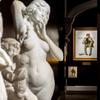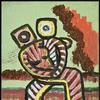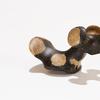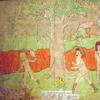The Classical Nudes of Pierre-Auguste Renoir
- November 16, 2021 15:59


Perhaps more than any other Impressionist, Renoir is celebrated for his figural work, especially his Rubenesque female nudes. However, it was not until the artist was in his forties that he depicted the nude with any frequency. In 1881, Renoir embarked upon a formative trip to Italy, where he studied the works of the Renaissance masters and the ancient art of Pompeii and Rome. Upon his return to France, the nude became his favored subject, and he used the motif to combine the spontaneity of Impressionism with the solid modeling of classical painting. The following decades of Renoir’s career would serve as evidence of his long-lasting artistic preoccupation with representations of the female nude.
Although Renoir is best known as a leader of the revolutionary Impressionist movement which rejected established art norms of the day, he began his artistic career studying traditional methods and subjects. He enrolled at the prestigious École des Beaux-Arts in Paris in his early 20s, studying under respected Academician and Salon staple, Charles Gleyre. Although certainly working within the conservative Academic tradition, favoring classical parables as his subject matter, Gleyre was known as an innovator within this tradition. He sought to apply modern ideas to the classics and developed along with Paul Delaroche and Thomas Couture a painting style known as juste-milieu or “happy medium,” which served as a kind of stepping stone between Academic and Impressionist painting. Preferring to avoid a very high finish, these works were marked by looser brushwork and a lighter palette while still maintaining high standards of draftsmanship.
Gleyre was undoubtedly instrumental in instilling in Renoir a deep appreciation for the traditional style of painting, while at the same time offering the young artist a version of Academicism infused with more progressive ideas. He also taught other revolutionary artists like Claude Monet, Alfred Sisley and James McNeill Whistler. Renoir, of course, became instrumental in establishing that famed group known as the French Impressionists, but he would return to his early love of the classics later in his career. The grand tradition of classical art, particularly nudes, captivated Renoir in the 1880s and onward, modernized, however, by the artist’s innovations within the Impressionist style.
Renoir left for Italy in the fall of 1881 and traveled across the country until mid-January of the following year. It was his first time in the country, and he took full advantage of his time there, stopping in Florence, Rome, Milan, Venice, Naples and more. His time in Rome made the biggest impression, and he wrote to his art dealer, Paul Durand-Ruel, of his admiration for Raphael’s frescoes in the Villa Farnesina, lamenting that he had not seen them earlier in life. From there, he became increasingly interested in contour, volume and line as opposed to the fleeting optical effects of light and atmosphere that preoccupied the Impressionists as a whole. His figural works took on a more structural, sculptural quality with careful attention to form, juxtaposed against loose, brushed backdrops.
The works here, which present women in serene, private moments, are far more intimate compared with the other variety of nude depictions Renoir is known for — his groups of bathers that frolic in nature. Their poses, turned away from the viewer, allow for only a glimpse of their faces and flushed cheeks. Partially covered with drapery, the women in each of these canvases recall instead a biblical Eve or a classical rendition of a modest Venus, successfully carrying a traditional academic motif into the avant-garde world of Impressionism. Noted art historian Kenneth Clark wrote that Renoir took the figure of Venus, which “had been cheapened, falsified, and fragmented” and discovered “how to give the female body that character of wholeness and order which was the discovery of the Greeks.” Here, Renoir’s nudes sit in tranquility, absorbed in their thoughts and tasks, becoming timeless figures of feminine beauty, much like the masterworks the artist enjoyed firsthand in Rome.
In both compositions, the artist’s mastery of light and shading is incredible, achieving a sense of vitality in otherwise quiet, ordinary scenes, a quality that defines the best of Renoir’s female figures. By the time they were completed, Renoir had already enjoyed great success as a portraitist, and his aforementioned trip to Italy led him to develop the increasingly singular artistic style with which we are most familiar today. A solo exhibition at the Durand-Ruel Gallery in Paris in 1883 confirmed his position as one of the leading artistic masters of the day.
Relying heavily upon composition, linear figures and descriptive details, Renoir’s paintings distinguished him among his contemporaries. His intuitive use of color and expansive brushstrokes, along with acute attention to his subject matter, have placed him among the finest painters in history. M.S. Rau is proud to offer a number of works by this important Impressionist artist. Click here to view our current collection of Renoir artworks.
About M.S. Rau:
M.S. Rau has spent more than 100 years earning the trust of discerning collectors worldwide. Located in the heart of New Orleans’ historic French Quarter, our peerless showroom houses one of the world’s most extensive and stunning collections of museum-quality fine art by artists such as Claude Monet and William Bouguereau, 18th- and 19th-century antiques and breathtaking jewelry, including rare colored diamonds.













![Peter Paul Rubens (Flemish, 1577–1640), After Titian (Tiziano Vecelli) (Italian [Venetian], c. 1488–1576), Rape of Europa, 1628–29. Oil on canvas, 71 7/8 x 79 3/8 in. Peter Paul Rubens (Flemish, 1577–1640), After Titian (Tiziano Vecelli) (Italian [Venetian], c. 1488–1576), Rape of Europa, 1628–29. Oil on canvas, 71 7/8 x 79 3/8 in.](/images/c/e2/2e/Jan20_Rape_of_Europa100x100_c.jpg)







